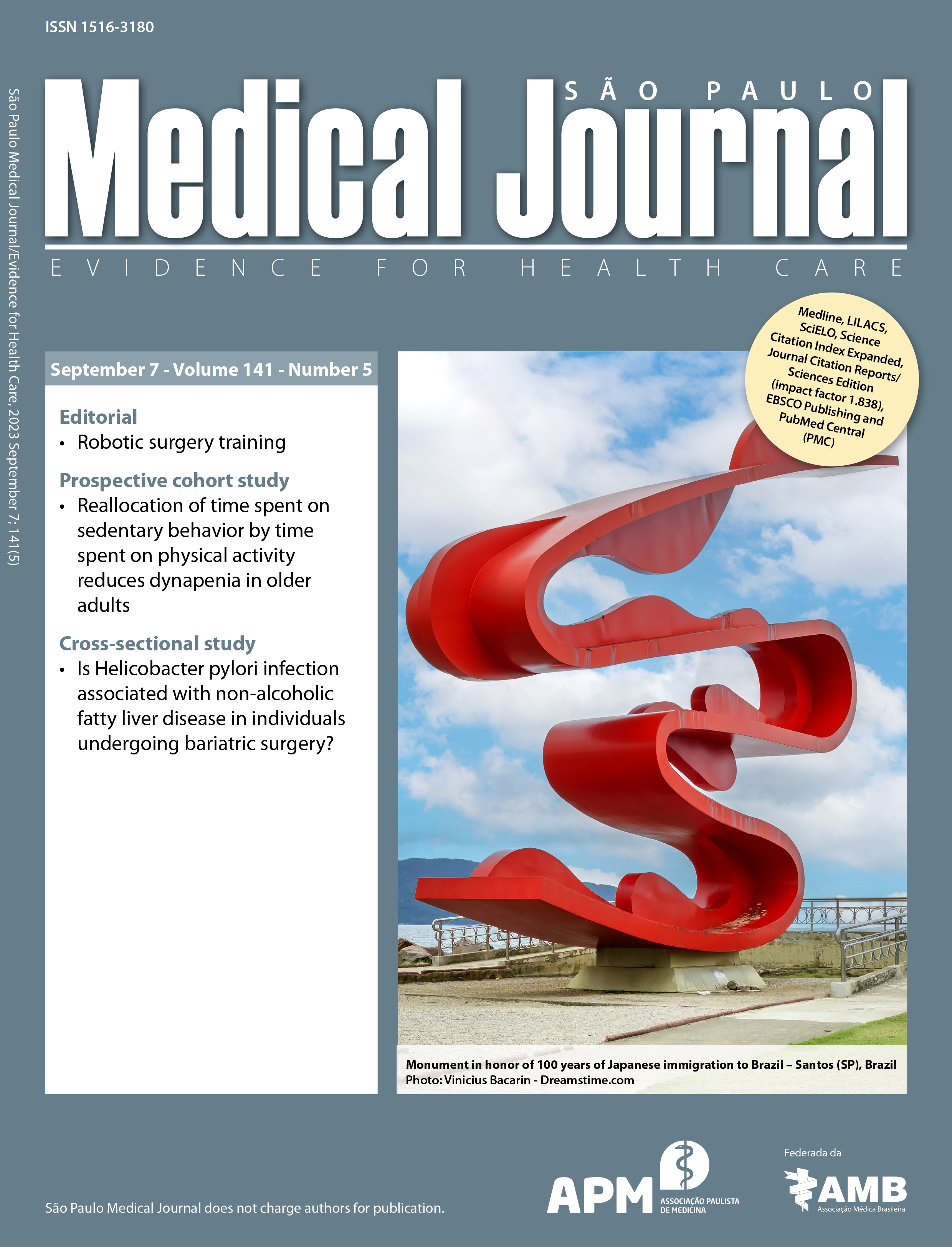The Brazilian Portuguese version of the Pregnancy Mobility Index
Cross-cultural adaptation and psychometric evaluation – a validation study
Keywords:
Pregnant women, Mobility limitation, Women’s health services, Lumbosacral region, Women’s healthAbstract
BACKGROUND: The Pregnancy Mobility Index (PMI) was developed to assess mobility in pregnant women in the Netherlands. At present, no similar questionnaire is available in Brazil. OBJECTIVE: The present study aimed to translate, cross-culturally adapt, and evaluate the psychometric properties of a Brazilian PMI. DESIGN AND SETTING: The present study was a validation study conducted at the Universidade Federal do Paraná and a public maternity ward in Curitiba, Brazil. METHODS: Text translation and cross-cultural adaptation followed international guidelines. Construct validity, internal consistency, and inter- and intra-rater reliability tests included 97 women. The Pelvic Girdle Questionnaire, Multidimensional Pain Evaluation Scale, Schober’s test, and lumbar spine range of motion assessment were administered on the first day. Intra-rater reliability (n = 19) was measured after 15 days. Exploratory factor analysis was performed, and the correlation matrix was analyzed using Pearson’s coefficient. RESULTS: Pregnant women (88%) understood the cultural adaptation process. The internal consistency was high (Cronbach’s alpha > 0.90), construct validity was moderate, with significant correlation between lumbar spine range of motion (r = 0.283–0.369) and Schober’s test (r = -0.314), and high correlation between the Multidimensional Pain Evaluation Scale (r = -0.650 and -0.499) and Pelvic Girdle Questionnaire (r = -0.737). Intra- and inter-rater reliabilities were excellent (intraclass correlation coefficient = 0.932 and 0.990, respectively). CONCLUSION: The Brazilian version of the PMI was successfully translated with excellent reliability and moderate-to-high construct validity. It is an important tool for assessing mobility in pregnant women. CLINICAL TRIAL: RBR-789tps (Validation study), https://ensaiosclinicos.gov.br/rg/RBR-789tps.
Downloads
References
Thabah MM, Ravindran V. Musculoskeletal problems in pregnancy. Rheumatol Int. 2015;35(4):581-7. PMID: 25253297; https://doi.org/10.1007/s00296-014-3135-7.
Kohlhepp LM, Hollerich G, Vo L, et al. Physiologische Veränderungen in der Schwangerschaft [Physiological changes during pregnancy]. Anaesthesist. 2018;67(5):383-96. German. PMID: 29654495; https://doi.org/10.1007/s00101-018-0437-2.
Simões LCF, Teixeira-salmela LF, Wanderley ELS, et al. Adaptação transcultural do “Pelvic Girdle Questionnaire” (PGQ) para o Brasil. Acta Fisiatr. 2016;23(4):166-71. https://doi.org/10.5935/0104-7795.20160032.
Van de Pol G, de Leeuw JR, van Brummen HJ, et al. The Pregnancy Mobility Index : a mobility scale during and after pregnancy. Acta Obstet Gynecol Scand. 2006;85(7):786-91. PMID: 16817074; https://doi.org/10.1080/00016340500456373.
Coluci MZ, Alexandre NM, Milani D. Construção de instrumentos de medida na área da saúde [Construction of measurement instruments in the area of health]. Cien Saude Colet. 2015;20(3):925-36. PMID: 25760132; https://doi.org/10.1590/1413-81232015203.04332013.
COSMIN. Guideline for Systematic Reviews of Outcome Measurement Instruments. Available from: https://www.cosmin.nl/tools/guideline-conducting-systematic-review-outcome-measures/. Accessed in 2022 (May 12).
van de Pol G. The influence of psychosocial factors on pregnancy related pelvic symptoms [Thesis]. Utrecht: Utrecht University; 2006. Available from: https://dspace.library.uu.nl/handle/1874/12838. Accessed in 2022 (May 12).
Beaton DE, Bombardier C, Guillemin F, Ferraz MB. Guidelines for the process of cross-cultural adaptation of self-report measures. Spine (Phila Pa 1976). 2000;25(24):3186-91. PMID: 11124735; https://doi.org/10.1097/00007632-200012150-00014.
Korelo RI, Kryczyk M, Garcia C, Naliwaiko K, Fernandes LC. Wound healing treatment by high frequency ultrasound, microcurrent, and combined therapy modifies the immune response in rats. Braz J Phys Ther. 2016;20(2):133-41. PMID: 26786082; https://doi.org/10.1590/bjptrbf.2014.0141.
Mokkink LB, Princen CAC, Patrick DL, et al. COSMIN Study Design checklist for Patient-reported outcome measurement instruments. Dep Epidemiol Biostat Amsterdam Public Heal Res Inst Amsterdam Univ Med Centers, Locat VUmc. 2019;(July):1-32. Available from: https://www.cosmin.nl/wp-content/uploads/COSMIN-study-designing-checklist_final.pdf. Accessed in 2022 (May 12).
Simões L, Teixeira-salmela LF, Magalhães L, et al. Analysis of Test-Retest Reliability, Construct Validity, and Internal Analysis of Test-Retest Reliability, Construct Validity, and Internal Consistency of the Brazilian Version of the Pelvic Girdle Questionnaire. J Manipulative Physiol Ther. 2018;41(5):425-33. PMID: 29703648; https://doi.org/10.1016/j.jmpt.2017.10.008.
Sousa FA, Pereira LV, Cardoso R, Hortense P. Multidimensional pain evaluation scale. Rev Lat Am Enfermagem. 2010;18(1):3-10. PMID: 20428690; https://doi.org/10.1590/S0104-11692010000100002.
Macedo C de SG, Souza PR de, Alves PM, Cardoso JR. Study of validity and intra and inter-observer reliability of modified-modified schöber test in subject with low-back pain. Fisioter Pesqui. 2009;16(3):233-8. https://doi.org/10.1590/S1809-29502009000300008
Marques AP. Manual de goniometria. São Paulo: Editora Manole; 2014.
Portney L, Watkins M. Foundations of Clinical Research: Applications To Practice. Philadelphia: F. A. Davis Company; 2015.
Hirakata VN, Camey S. Análise de Concordância entre Métodos de Bland-Altman. Rev HCPA. 2009;29(3). Available from: https://seer.ufrgs.br/hcpa/article/view/11727. Accessed in 2022 (May 12).
Hopkins WG. Measures of reliability in sports medicine and science. Sport Med. 2000;30(1):1-15. PMID: 10907753; https://doi.org/10.2165/00007256-200030010-00001.
Terwee CB, Bot SD, de Boer MR, et al. Quality criteria were proposed for measurement properties of health status questionnaires. 2007;60(1):34-42. PMID: 17161752; https://doi.org/10.1016/j.jclinepi.2006.03.012.
Mokkink LB, Terwee CB, Patrick DL, et al. The COSMIN study reached international consensus on taxonomy, terminology, and definitions of measurement properties for health-related patient-reported outcomes. J Clin Epidemiol. 2010;63(7):737-45. PMID: 20494804; https://doi.org/10.1016/j.jclinepi.2010.02.006.
Barros RR, Simões L, Moretti E, Lemos A. Repercussion of pelvic girdle pain on pregnant women’s functionality evaluated through the Brazilian version of the Pelvic Girdle Questionnaire (PGQ-Brazil): a cross-sectional study. Fisioter Pesq. 2015;22(4):404-10. https://doi.org/10.590/1809-2950/14342922042015.
Carvalho MECC, Lima LC, Lira Terceiro CA, et al. Low back pain during pregnancy. Rev Bras Anestesiol. 2017;67(3):266-70. http://dx.doi.org/10.1016/j.bjane.2015.08.014.
Gallo-Padilla D, Gallo-Padilla C, Gallo-Vallejo FJ, Gallo-Vallejo JL. Lumbalgia durante el embarazo. Abordaje multidisciplinar [Low back pain during pregnancy. Multidisciplinary approach]. Semergen.. 2016;42(6):e59-64. PMID: 26239672; https://doi.org/10.1016/j.semerg.2015.06.005.
Bakker EC, van Nimwegen-Matzinger CW, Ekkel-van der Voorden W, Nijkamp MD, Völlink T. Psychological determinants of pregnancy-related lumbo- pelvic pain: a prospective cohort study. Acta Obstet Gynecol Scand. 2013;92(7):797-803. PMID: 23465064; https://doi.org/10.1111/aogs.12131.
Liddle SD, Pennick V. Interventions for preventing and treating low-back and pelvic pain during pregnancy. Cochrane Database Syst Rev. 2015;2015(9):CD001139. PMID: 26422811; https://doi.org/10.1002/14651858.CD001139.pub4.
Leal MDC, Gama SGND, Pereira APE, et al. The color of pain: racial iniquities in prenatal care and childbirth in Brazil. Cad Saude Publica. 2017;33Suppl 1(Suppl 1):e00078816. PMID: 28746555; https://doi.org/10.1590/0102-311X00078816.






